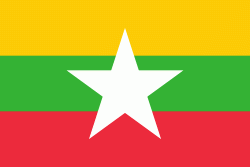Myanmar kyat
Ks
The kyat (, or ; ကျပ် ; ISO 4217 code MMK) is the currency of Myanmar (Burma). The typical notation for the kyat is "K" (singular) and "Ks." (plural), placed before the numerals followed by "/-"The term kyat derives from the ancient Burmese unit kyattha (ကျပ်သား), equal to 16.3 (16.329324593) grams of silver.
From 2001 to 2012, the official exchange rate varied between Ks. 5/ 75 and Ks. 6/ 70 per US dollar (Ks. 8/ 20 to Ks. 7/- per euro). However, the street rate (black market rate), which more accurately took into account the standing of the national economy, has varied from Ks.750/- to Ks.1,335/- per USD (Ks.985/- to Ks.1,475/- per EUR). The black market exchange rates (USD to MMK) decrease during the peak of the tourist season in Burma (December to January).
On 2 April 2012, the Central Bank of Myanmar announced that the value of the kyat against the US dollar would float, setting an initial rate of Ks.818/- per US dollar.
On 20 March 2013, the Finance Ministry announced that it would abolish Foreign Exchange Certificates (FEC), which were mandatory for tourists to buy at least US$200 worth of until 2003, a measure used to discourage visitors from exchanging on the black market.
More than a year after a coup d'état caused the overthrow of a democratically-elected government, capital flight from Myanmar and inflation accelerated, causing the value of the kyat to plummet to 3500 kyats per USD in the informal market.
Country
-
Burma
Myanmar, officially the Republic of the Union of Myanmar, also known as Burma (the official name until 1989), is a country in Southeast Asia. It is the largest country by area in Mainland Southeast Asia, and has a population of about 54 million as of 2017. It is bordered by Bangladesh and India to its northwest, China to its northeast, Laos and Thailand to its east and southeast, and the Andaman Sea and the Bay of Bengal to its south and southwest. The country's capital city is Naypyidaw, and its largest city is Yangon (Rangoon).
Early civilisations in the area included the Tibeto-Burman-speaking Pyu city-states in Upper Myanmar and the Mon kingdoms in Lower Myanmar. In the 9th century, the Bamar people entered the upper Irrawaddy valley, and following the establishment of the Pagan Kingdom in the 1050s, the Burmese language, culture, and Theravada Buddhism slowly became dominant in the country. The Pagan Kingdom fell to Mongol invasions, and several warring states emerged. In the 16th century, reunified by the Taungoo dynasty, the country became the largest empire in the history of Southeast Asia for a short period.
